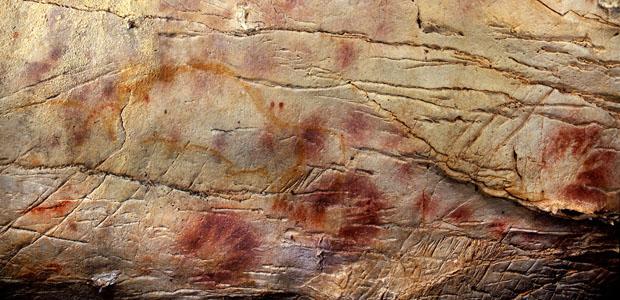Scientist discover evidence of Neanderthals being responsible for early cave paintings
The Panel of Hands, El Castillo Cave, Spain. A hand stencil has been dated to earlier than 37,300 years ago and a red disk to earlier than 40,600 years ago, making them the oldest cave paintings in Europe. (Photo by Pedro Saura.)
Ancient cave paintings have a way of connecting us to our past as a species.
The art offers a glimpse of how our early ancestors thought and lived, and it’s hard not to wonder who made the paintings.
A new study in the journal Science raises an intriguing possibility. Researchers have found cave art that’s older than any previously dated. In fact, it’s so old that it may not have been painted by modern humans.
The caves in question are on the northern coast of Spain.
“We visited eleven caves in Cantabria and Asturias,” said Alistair Pike, an archaeologist at the University of Bristol.
One of those caves was Altamira, where prehistoric artwork was first discovered in the 19th century. Altamira is famous for its elaborate, three-dimensional images of bison and other animals, as well as simpler drawings of red dots and hand stencils.
The paintings in these caves had already been dated by previous researchers, but Pike says those dates were unreliable. Dating cave art is tricky business.
“The primary dating methods that archaeologists use, radiocarbon dating, is not suitable for paintings that are made purely from mineral pigments, or engravings,” he said
So Pike and his colleagues developed what they say is a more accurate approach. It relies on something that naturally happens to most cave art over the centuries.
“These paintings in caves have forming on top of them very thin calcium carbonate crusts,” he said. “And they’re formed by the same processes that form stalagmites and stalactites in caves.”
Scientists can determine when these crusts formed by looking at tiny amounts of radioactive uranium, which slowly decays into thorium. Once scientists determine the date of the crust, they know that the painting lying underneath must be older.
So Pike and his team applied this technique to the Spanish caves, and they found that some of the artwork was much older than anyone expected.
A cave in Cantabria had the oldest piece of art.
“It’s a red disk that dates to older than 40,800 years,” he said.
That makes it at least several thousand years older than what had previously been considered the oldest cave art.
And Pike’s colleague, Joao Zilhão, of the University of Barcelona, points out that the age estimate is just a minimum age for the painting.
“It could be 40.5 (thousand years old), 42,000, 45,000, 50,000,” he said.
This means the artwork may predate by thousands of years when modern humans arrived in Europe.
So who was the artist? Zlihão suspects it was a Neanderthal. Neanderthals lived in Europe long before modern humans arrived from Africa.
Scientists used to think that Neanderthals were our dumber, less evolved cousins — not the artistic type. But research over the past decade has revealed a rather different picture.
We now know that Neanderthals probably cooked their food and made tools for hunting and fishing. They were also culturally more sophisticated than previously thought.
“Neanderthals engaged in body painting,” Zilhão said. “They used pendants. We have evidence of the use of perforated marine shells, perforated animal teeth — used as pendants.”
So it is not too far-fetched to assume that they might have been painting caves too.
Julien Riel-Salvatore, an anthropologist at the University of Colorado in Denver, studies Neanderthals.
He says the new report does raise a provocative possibility about the origin of cave art, but he’s not entirely convinced.
“I would still hold my breath a little bit longer before asserting that Neanderthals were involved here,” he said.
Riel-Salvatore says he’d be more likely to believe that Neanderthals painted in caves if future research turned up stronger evidence. For instance, if Neanderthal tools were found close to the artwork, or if scientists found cave paintings even older than the ones in the new study.
The authors of the new study are already on it. They’re scouring caves all over Europe for signs of older paintings.
